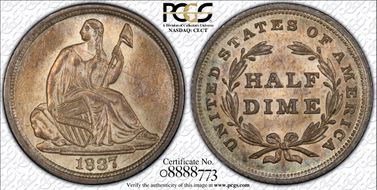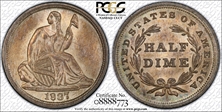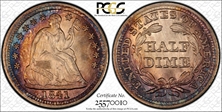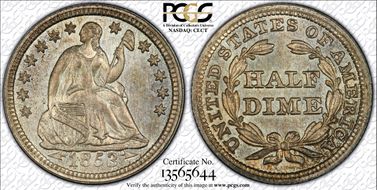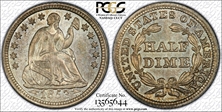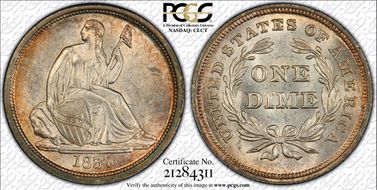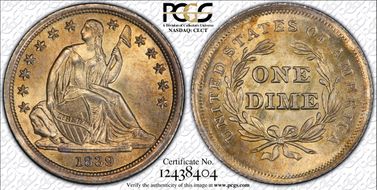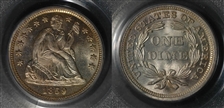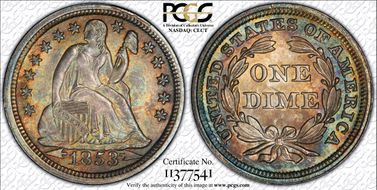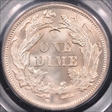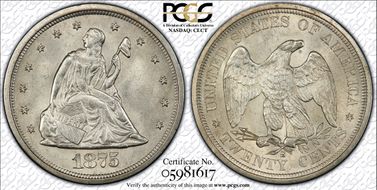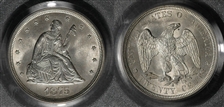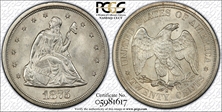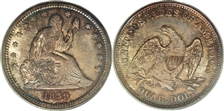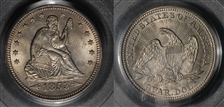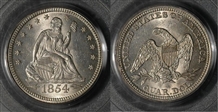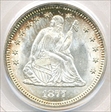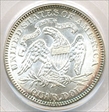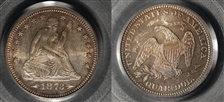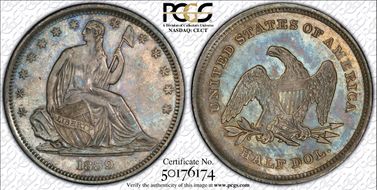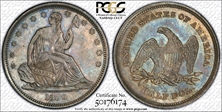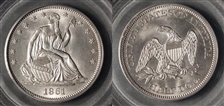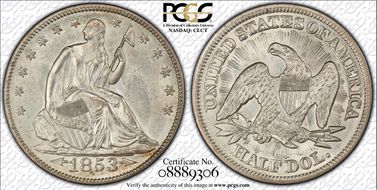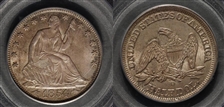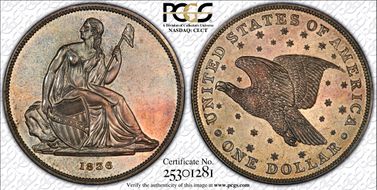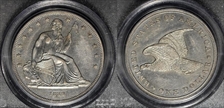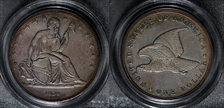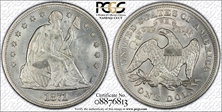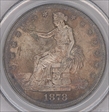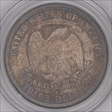Gobrecht's Raisinet Collection 的钱币相册
1837 H10C Large Date (Curl Top 1) MS65. This is the variety with the numeral 8 tripled below. The digits 1, 3, and 7 are each doubled below. Both sides have frosty gold and ivory surfaces with intense luster. The No Stars obverse provides a glimpse at Christian Gobrecht's Seated Liberty design in its purest unencumbered form, free of extraneous details. From The Troy Wiseman Collection.
1837 H10C Large Date (Curl Top 1) MS65. This is the variety with the numeral 8 tripled below. The digits 1, 3, and 7 are each doubled below. Both sides have frosty gold and ivory surfaces with intense luster. The No Stars obverse provides a glimpse at Christian Gobrecht's Seated Liberty design in its purest unencumbered form, free of extraneous details. From The Troy Wiseman Collection.
1838 No Drapery MS65. Small Stars. V-1. "The 1838 Half Dime is found in two major varieties: Large Stars and Small Stars. Actually, the Small Stars variety started out as a Large Stars die that was subsequently ground down to remove clashmarks, thus reducing the apparent size of the stars." (Ron Guth). Described on the insert as a No Drapery piece with no mention of what appears to be the Small Stars feature, considerably scarcer than the Large Stars variety, especially in higher grades. This scarce Gem quality, first-year-type variety was created by drastically repolishing the obverse die to remove rust. But Liberty's arm is rusted, and many of the stars are attenuated from repeated, overzealous die polishing that was probably meant to lessen, if not remove the former feature. As a result, the stars were reduced in size. A considerably scarcer variety of this first year No Drapery type than the "normal" stars version, perhaps fewer than 10% of the uncirculated 1838 half dimes are the Small Stars design. V-1 specimens generally exhibit a strong strike with full head, toe and shield and the date boldly punched. Early strikes of the V-1 show a repunched first 8. The present example appears to be an early die state with the figure of Liberty only showing partial die rust, not "badly corroded" as Valentine stated. This coin seems to be an exceptionally sharp example of Al Blythe's Die State 2, with notable die rust on Liberty's arm and some doubling of the drastically lapped small stars. Later die states show die deterioration with a die crack from rim to head and Liberty’s right shoulder to the rim. The die state only refers to the obverse as the reverse is distinct from that used on examples of the V-2 die marriage. (The obverse die was used for both varieties.) The No Drapery, Stars Seated Half Dime was produced from 1838-1840. VARIETIES: V-1 with level date, centered. V-2 with low date running uphill toward base of rock. SCARCITY: V-2 far scarcer than V-1. Rarity Rating, V-1: G-VG R5, F-VF R5, EF-AU R6, MS R7.
1841 H10C MS67 V-2 Mintage: 50,000. The last 1 in the date is low and recut, and a small lunule appears between stars 10 and 11. Sharply struck, this is an extraordinarily well-preserved Superb Gem of this type, with full original luster and an exemplary strike, struck from moderately clashed dies. The surfaces emit a warm glow, with lightly toned, golden-rose centers and rich golden-brown, mauve and cobalt-blue peripheral colors about the rims. This second year of the Drapery sub-type is more available than its introductory 1840 counterpart, but relatively few pieces have been certified by PCGS in Mint State grades. Among half dime collectors the 1841 is considered a common date, but it certainly is uncommon in MS67 condition. VARIETIES: V-1 (Proof only). V-2 and V-3 represent variations of the date replacement. There is also a repunched date (RPD) variety with a repunched 1 at the top, and a reverse with heavy lettering designated V-4. The V-2 in late die states exhibits a significant die crack running diagonally from 2 to 7 o’clock. Evidencing not a hint of a crack, this piece would seem to be an example of a much earlier die state. The V-2 variety usually is strongly struck, other than minor weakness of dentils on the reverse, with a full head, shield and toe. The date and stars are boldly punched. The pendant lines up just right of the upright of the 4, and the shield points to the top of the 1.
1841 H10C MS67 V-2 Mintage: 50,000. The last 1 in the date is low and recut, and a small lunule appears between stars 10 and 11. Sharply struck, this is an extraordinarily well-preserved Superb Gem of this type, with full original luster and an exemplary strike, struck from moderately clashed dies. The surfaces emit a warm glow, with lightly toned, golden-rose centers and rich golden-brown, mauve and cobalt-blue peripheral colors about the rims. This second year of the Drapery sub-type is more available than its introductory 1840 counterpart, but relatively few pieces have been certified by PCGS in Mint State grades. Among half dime collectors the 1841 is considered a common date, but it certainly is uncommon in MS67 condition. VARIETIES: V-1 (Proof only). V-2 and V-3 represent variations of the date replacement. There is also a repunched date (RPD) variety with a repunched 1 at the top, and a reverse with heavy lettering designated V-4. The V-2 in late die states exhibits a significant die crack running diagonally from 2 to 7 o’clock. Evidencing not a hint of a crack, this piece would seem to be an example of a much earlier die state. The V-2 variety usually is strongly struck, other than minor weakness of dentils on the reverse, with a full head, shield and toe. The date and stars are boldly punched. The pendant lines up just right of the upright of the 4, and the shield points to the top of the 1.
1853 H10C Arrows MS65. Delicate green-gold tints drape otherwise pale silver-gray surfaces. A moderately reflective Gem that has excellent eye appeal.
1853 H10C Arrows MS65. Delicate green-gold tints drape otherwise pale silver-gray surfaces. A moderately reflective Gem that has excellent eye appeal.
1872-S H10C Mintmark Below MS66. The silver-gray surfaces of this Premium Gem are awash in mint luster. A nicely preserved coin that reflects a well executed strike.
1872-S H10C Mintmark Below MS66. The silver-gray surfaces of this Premium Gem are awash in mint luster. A nicely preserved coin that reflects a well executed strike.
1837 10C Large Date MS64. Dripping with mint frost and displaying a sharp strike, just a few minor abrasions are noted in the fragile fields. Some deep golden border color is presented mostly on the obverse side. From the Gil Clark Collection.
1837 10C Large Date MS64. Dripping with mint frost and displaying a sharp strike, just a few minor abrasions are noted in the fragile fields. Some deep golden border color is presented mostly on the obverse side. From the Gil Clark Collection.
A solidly struck and highly lustrous near-Gem, considerably more appealing than the Choice designation would suggest. This is a wonderfully appealing example of this early Seated dime issue, sharply struck with light golden-orange patina over each side. Outstanding eye appeal and practically no visible blemishes.
A solidly struck and highly lustrous near-Gem, considerably more appealing than the Choice designation would suggest. This is a wonderfully appealing example of this early Seated dime issue, sharply struck with light golden-orange patina over each side. Outstanding eye appeal and practically no visible blemishes.
Low Mintage and Conditionally Scarce 1859 Seated Liberty Dime MS65. Just 430,000 Seated Dimes emerged from the Philadelphia Mint in 1859, and the issue is only considered common in grades below VF. A semi-prooflike Gem, both sides are noticeably reflective in the fields with some striations (as produced) evident on the obverse. Both sides are bright with minimal golden tinting and a sharp overall appearance. There are remarkably few distractions, as befits the technical grade that has been assigned.
1853 10C Arrows MS65. A Gem example of this silver type, only minted during the years 1853-55 due to the revaluation of silver as a result of the immense hoards of newfound California gold. In the early 1850s, with an excessive quantity of gold in the financial markets, the value of silver increased to the point that the metal value of silver coins was greater than the face value. This led to hoarding and mass melting of these coins. To resolve the problem, legislation was passed by Congress to reduce the weight of the half dimes, dimes, quarters, and half dollars. When the weight of silver coins was reduced in 1853, it was designated by small arrowheads placed on either side of the date to alert the general populace of this weight reduction. This caused two things to occur: first, the old (heavier) coins were widely melted, and second, the new (lighter) coins were saved in relatively large numbers because of the noticeable design alteration. This piece is a superior Gem example of this popular and short-lived, first-year Arrows design. The surfaces are smooth, the strike is razor sharp, and the devices are sharply impressed throughout. There are no significant abrasions, and the luster is thick but slightly subdued under the patina. The surfaces are bursting with a swirling mixture of orange-gold, turquiose and pale lavender toning that permeates both sides and is well balanced on each side, and highlights the central devices with peripheral halos of color. Even though a few dozen Arrows dimes have been certified by the major grading services at higher levels, it would be hard to surpass the eye appeal of this outstanding type coin. This is a simply gorgeous Gem that will endear itself to anyone who appreciates colorful, originally toned coins. Although a high mintage issue, the Arrows, Stars Obverse was only coined for three years, and examples of this exceptional quality remain scarce.
1853 10C Arrows MS65. A Gem example of this silver type, only minted during the years 1853-55 due to the revaluation of silver as a result of the immense hoards of newfound California gold. In the early 1850s, with an excessive quantity of gold in the financial markets, the value of silver increased to the point that the metal value of silver coins was greater than the face value. This led to hoarding and mass melting of these coins. To resolve the problem, legislation was passed by Congress to reduce the weight of the half dimes, dimes, quarters, and half dollars. When the weight of silver coins was reduced in 1853, it was designated by small arrowheads placed on either side of the date to alert the general populace of this weight reduction. This caused two things to occur: first, the old (heavier) coins were widely melted, and second, the new (lighter) coins were saved in relatively large numbers because of the noticeable design alteration. This piece is a superior Gem example of this popular and short-lived, first-year Arrows design. The surfaces are smooth, the strike is razor sharp, and the devices are sharply impressed throughout. There are no significant abrasions, and the luster is thick but slightly subdued under the patina. The surfaces are bursting with a swirling mixture of orange-gold, turquiose and pale lavender toning that permeates both sides and is well balanced on each side, and highlights the central devices with peripheral halos of color. Even though a few dozen Arrows dimes have been certified by the major grading services at higher levels, it would be hard to surpass the eye appeal of this outstanding type coin. This is a simply gorgeous Gem that will endear itself to anyone who appreciates colorful, originally toned coins. Although a high mintage issue, the Arrows, Stars Obverse was only coined for three years, and examples of this exceptional quality remain scarce.
1887 10C MS66. Cobalt-blue, gray, and lavender toning dances over lustrous surfaces. Well struck, except for the hair on Liberty's head and the bow knot. No major blemishes are apparent.
1887 10C MS66. Cobalt-blue, gray, and lavender toning dances over lustrous surfaces. Well struck, except for the hair on Liberty's head and the bow knot. No major blemishes are apparent.
1874 10C Arrows MS66. Light orange toning visits the primarily silver-white surfaces. This Premium Gem is lustrous and well struck, and both sides are splendidly unabraded. The second and final year of the Arrows, Legend Obverse subtype. Housed in a green label holder.
1874 10C Arrows MS66. Light orange toning visits the primarily silver-white surfaces. This Premium Gem is lustrous and well struck, and both sides are splendidly unabraded. The second and final year of the Arrows, Legend Obverse subtype. Housed in a green label holder.
Lustrous and Attractively Toned MS64 1839 No Drapery Quarter. Closed Claws Reverse. (The 1839 No Drapery is found both with the Closed Claws reverse of 1838, and the Open Claws reverse of 1839.) The device punches for what would become the Seated Liberty Quarter were completed by Christian Gobrecht during the summer of 1838. After 20 "specimens" were sent to Treasury Secretary Levi Woodbury, regular production commenced on September 29. The Philadelphia Mint produced at least 466,000 examples this year, all of which, like their 1839 and 1840-O No Drapery counterparts, lacked obverse drapery folds at Liberty's right (facing) elbow. All three of these issues are scarce in problem-free Uncirculated preservation, and what few coins have been certified at the upper reaches of the Mint State grading scale are usually snatched up quickly by type collectors when they appear on the market. Writing in 1991, Larry Briggs says of this issue: "Head, stars, and obverse dentils are poorly struck." Many examples of this issue are poorly struck, and this piece shows noticeable softness on the upper obverse and the right (facing) quadrant, and correspondingly on the lower reverse. The delectable original toning, in shades of silver-pink and electric blue, compensates somewhat, and there are few signs of contact. Seldom seen finer. From The Palakika Collection.
1858 25C MS65. The high mintage figures for Seated quarters inaugurated by the Mint Act of February 21, 1853 continued at the Philadelphia Mint through 1858. Arrows were removed from the design in 1856 after a three-year run, although they would briefly return in 1873. Although there was no longer a need for a distinguishing feature on the obverse or reverse of the Seated Quarter, mintage figures remained high at the Philadelphia mint from 1856 through 1861. The 1857 boasts the highest total in this group with more than 9.6 million pieces delivered. As such, it is a popular representative of the No Motto type in all grades. The high mintage 1858 Quarter is also one of the few issues of the No Motto type that can occasionally be found at the Gem level. From a large mintage of 7.3 million pieces, the 1858 Seated Liberty quarter is also a popular choice for type collectors seeking a No Motto representative. However, examples are seldom encountered at the Gem level of preservation. The present coin is a magnificent Gem, with pristine, brilliant surfaces and vibrant, frosty mint luster. Both sides are sharply defined by a razor-sharp strike, including the obverse stars and the eagle's neck feathers. The incredible visual appeal of this specimen is off the chart. Richly frosted and undeniably smooth, this coin is crisply detailed in all areas.
Well Struck 1853 Arrows and Rays Near-Gem Quarter MS64. The 1853 Arrows and Rays quarter dollar is extremely common in circulated grades, as would be expected from a mintage of more than 15 million pieces. Mint State coins present a different picture, however. Uncirculated examples through MS64, while available with a little searching and patience, can be difficult to locate, and higher-grade pieces are quite elusive. This near-Gem specimen yields light golden-gray color over glowing luster, along with well struck design elements. A few trivial obverse marks prevent an even higher grade. From The Lanterman's Mill Collection
1854 25C Arrows MS64. Delicate straw-gold patina graces this lustrous and intricately struck near-Gem. The few minor luster grazes are expected of the grade. High quality examples of the 1854 are always in demand as representatives of the briefly produced Arrows, No Rays, No Motto type.
1877 25C MS66. Type Two Reverse. The 1877 Seated Liberty quarter is more difficult to locate than the mintage of nearly 11 million pieces would suggest. Many examples were melted in 1878 to provide silver bullion for Morgan dollars. The present coin is a well-struck Premium Gem, with lustrous surfaces and gold and violet highlights. The reverse displays extensive die cracks and clash marks.
1877 25C MS66. Type Two Reverse. The 1877 Seated Liberty quarter is more difficult to locate than the mintage of nearly 11 million pieces would suggest. Many examples were melted in 1878 to provide silver bullion for Morgan dollars. The present coin is a well-struck Premium Gem, with lustrous surfaces and gold and violet highlights. The reverse displays extensive die cracks and clash marks.
1839 50C No Drapery MS62. This is a splendid Mint State example with deep steel and gray toning over satiny silver surfaces. The reverse has additional vibrant blue color. A sharply struck example with excellent eye appeal. This is a partial-year type coin, struck for a short time in 1839 and highly elusive in Mint State grades. Diagonal planchet striations are evident at the center of the reverse. Population: 4 in 62, 21 finer (8/06). From The Troy Wiseman Collection.
1839 50C No Drapery MS62. This is a splendid Mint State example with deep steel and gray toning over satiny silver surfaces. The reverse has additional vibrant blue color. A sharply struck example with excellent eye appeal. This is a partial-year type coin, struck for a short time in 1839 and highly elusive in Mint State grades. Diagonal planchet striations are evident at the center of the reverse. Population: 4 in 62, 21 finer (8/06). From The Troy Wiseman Collection.
PQ. A solidly struck and highly lustrous near-Gem from the Civil War years. Only a few stray marks appear on the cream-tinted surfaces. An uncommonly appealing No Motto piece.
1853 50C Arrows and Rays MS64 PCGS. Traces of golden-brown toning appear at 12 and 5 o'clock on the obverse. The satiny surfaces are otherwise pearl-gray. A sharply struck example of this scarce one-year design type with a few tiny marks on each side that keep the piece from Gem status.
1853 50C Arrows and Rays MS64 PCGS. Traces of golden-brown toning appear at 12 and 5 o'clock on the obverse. The satiny surfaces are otherwise pearl-gray. A sharply struck example of this scarce one-year design type with a few tiny marks on each side that keep the piece from Gem status.
1854-O 50C Arrows MS64. The antebellum O-mint production of this issue was a generous quantity in excess of 5.2 million coins, and with the Arrows feature to boot, the issue is frequently pursued for type coin purposes. According to Seated half expert Bill Bugert, there are 55 obverse dies and 33 reverse dies known for the issue, and some "interesting and rare" die marriages exist. An important branch mint example of this short-lived design type, the bulk of Half Dollar production during the years 1854 and 1855, the years in which the Arrows design was employed, went to the New Orleans Mint. Consequently, the majority of high grade survivors are O-mints. Sharply defined throughout, this near-Gem Choice example has good cartwheel luster. There are no significant abrasions, and willowy silver-gray patina blankets the well preserved, lustrous surfaces of this near-Gem, Choice Uncirculated example. The strike is among the strongest seen on an 1854-O Arrows Half. Every feature (the obverse star centrils and the eagle's right leg on the reverse included) is fully brought up, this despite a shattered obverse die as evidenced by numerous cracks. The dies for this coin attest to long use, as several small die cracks appear on each side. An interesting series of peripheral die cracks (as produced) is noted along the right (facing) obverse periphery, and along the lower reverse border (also as struck), pointing to a later die state, a testament to the compelling need for these new tenor pieces in circulation.
1884 50C Repunched Date, WB-102, MS66 PCGS. The motto IN GOD WE TRUST was added to the reverse of Seated Liberty coinage in 1866. Although the Civil War ended in 1865, the resumption of specie payments would have to wait for the passage of the Mint Act of February 12, 1873. As such, deliveries of half dollars from 1866-1873 remained low with the exception of a few S-mint issues. The first-year the Motto Half Dollar was produced was 1866, but only to the extent of only 745,625 pieces versus the 3.2 million pieces that were struck of the 1875-S. The P-mint Seated halves from 1879 to 1890 have tiny mintages, as series specialists can attest. This is due primarily to the millions of Morgan dollars that the Philadelphia Mint pumped out with annual celerity, mandated by the Bland-Allison Act. Mintages of Seated half dollars from 1879 to 1890 ranged from 4,400 to 12,001 business strikes per year. Of them all, the 1882 and 1884 mintages are tied for the smallest—4,400 pieces each year—as sufficient quantities of half dollars were in circulation. In effect, the paltry production makes every coin a first-strike representative, hence the larger proportion of markedly proof-like survivors. This popular issue has one of the smallest mintages in not only the Seated half dollar series, but all half dollar series from 1794 to present. Judging by the certified population data, collectors and/or the general public were certainly aware of the tiny mintages, as the numbers extant today are several times the typical surviving population. Of the 4,400 business-strike Seated Liberty half dollars struck in 1884, some of the rare high-grade examples, like the present coin, show deeply reflective proof-like fields. A spectacular gem example of this low mintage, late date Seated half, it is fully struck and the design elements are sharply detailed. The strike is razor-sharp throughout and tiny, well-concealed marks fail to distract. Originality is a hallmark of both sides. Rich toning in shades of cobalt-blue, violet, red, and golden-amber enhance the visual quality of this remarkable Premium Gem, forming a beautiful halo around untoned centers. The thickly frosted portraits of Liberty and the eagle generate significant, albeit undesignated proof-like contrast against the partly mirrored fields. The reverse fields are essentially fully proof-like. This toned, proof-like piece has high field-device contrast and only the most minor distractions. Highly reflective luster adds to the wonderful eye appeal of this superb coin, an exemplary 1884 half. Variety WB-102 with a Recut 4, struck from the business-strike die, the present coin shows minor recutting on the base of the 4. All circulation strikes show the 4 slightly recut north. A business strike-only die pairing, and one of only two, the other being the rare variant with the top of an errant 8 in the denticles beneath the 8 and 4. Provenance: Larry Whitlow
1874 50C Arrows MS63. Sharply struck and highly lustrous with frosty silver surfaces. Both sides are attractive with full brilliance and no trace of toning. Minor surface marks and abrasions keep this from the Choice category. An important type coin.
Top: PR58, Bot: PR45; 1839 PS$1 Name Omitted, Judd-104 Original, Pollock-116, R.3 Silver. Reeded Edge. Die Alignment IV, "original" issue of 1839. Mostly untoned. A bright and gleaming specimen whose mirrored luster seems poised to detonate like a Fourth of July skyrocket; and there is a touch of faint friction on the high points accounting for the conservative grade. More than adequately struck for the Type, these tend to show razor-sharpness on the shield, on Liberty's gown and hair, as well as on the eagle's body. A representative example of Gobrecht's artistic silver dollar masterpiece. As of April 2009, out of a PCGS population of only 18, these are two of just six 1939 proof silver dollars that PCGS has judged to be both original and "impaired" (i.e., circulated) proofs. The head of Liberty is nearly opposite the F in OF, and therefore is in Die Alignment IV orientation. A full figure of Liberty, with shield and Phrygian (“Liberty”) cap on a pole, is the main design element on the obverse. The 26 stars that had been placed on the reverse of the 1836 dollars have now been removed, and 13 stars are now seen around the figure of Liberty on the obverse. A majestic flying eagle (symbolizing the United States) adorns the reverse surrounded by the legend UNITED STATES OF AMERICA and the denomination: ONE DOLLAR. All of the 1839 dollars made in 1839 are thought to have been deposited into the US banking system. Therefore, by default, the Gobrecht dollars issued in 1839 are regular issued coins (even though they were struck in proof format). All Gobrecht dollars are assigned Judd numbers, suggesting that these coins are patterns. But this conclusion is not correct. In fact, the Gobrecht dollars made in 1836, 1837, and 1839 are regular issued coins, and therefore are not patterns. Nevertheless, for historical reasons, it appears that these coins will continue to be incorrectly identified as patterns. The only real Gobrecht dollar pattern coins are the Judd-58 (name below base) and the J-84 (1838 dollar). Gobrecht dollars represent a short, 3-year series, with two different "types" of coins. The first type consists of the issue of 1836 with the no-star obverse design, and the second type includes the 1838 and 1839 dollars with obverse stars but no reverse stars. Another interesting observation is that Gobrecht dollars are the only Proof coins intentionally made for general distribution. Gobrecht dollars are one of the most fascinating and yet confusing series of silver dollars ever made by the US Mint.
Top: PR58, Bot: PR45; 1839 PS$1 Name Omitted, Judd-104 Original, Pollock-116, R.3 Silver. Reeded Edge. Die Alignment IV, "original" issue of 1839. Mostly untoned. A bright and gleaming specimen whose mirrored luster seems poised to detonate like a Fourth of July skyrocket; and there is a touch of faint friction on the high points accounting for the conservative grade. More than adequately struck for the Type, these tend to show razor-sharpness on the shield, on Liberty's gown and hair, as well as on the eagle's body. A representative example of Gobrecht's artistic silver dollar masterpiece. As of April 2009, out of a PCGS population of only 18, these are two of just six 1939 proof silver dollars that PCGS has judged to be both original and "impaired" (i.e., circulated) proofs. The head of Liberty is nearly opposite the F in OF, and therefore is in Die Alignment IV orientation. A full figure of Liberty, with shield and Phrygian (“Liberty”) cap on a pole, is the main design element on the obverse. The 26 stars that had been placed on the reverse of the 1836 dollars have now been removed, and 13 stars are now seen around the figure of Liberty on the obverse. A majestic flying eagle (symbolizing the United States) adorns the reverse surrounded by the legend UNITED STATES OF AMERICA and the denomination: ONE DOLLAR. All of the 1839 dollars made in 1839 are thought to have been deposited into the US banking system. Therefore, by default, the Gobrecht dollars issued in 1839 are regular issued coins (even though they were struck in proof format). All Gobrecht dollars are assigned Judd numbers, suggesting that these coins are patterns. But this conclusion is not correct. In fact, the Gobrecht dollars made in 1836, 1837, and 1839 are regular issued coins, and therefore are not patterns. Nevertheless, for historical reasons, it appears that these coins will continue to be incorrectly identified as patterns. The only real Gobrecht dollar pattern coins are the Judd-58 (name below base) and the J-84 (1838 dollar). Gobrecht dollars represent a short, 3-year series, with two different "types" of coins. The first type consists of the issue of 1836 with the no-star obverse design, and the second type includes the 1838 and 1839 dollars with obverse stars but no reverse stars. Another interesting observation is that Gobrecht dollars are the only Proof coins intentionally made for general distribution. Gobrecht dollars are one of the most fascinating and yet confusing series of silver dollars ever made by the US Mint.
1871 Liberty Seated Dollar MS-63. Brilliant white, intensely frosty and choice for the grade. The blast of snow-white color comes with a change to more subtle frost on the main devices. The only weak area in the strike is seen at a few obverse stars.
1871 Liberty Seated Dollar MS-63. Brilliant white, intensely frosty and choice for the grade. The blast of snow-white color comes with a change to more subtle frost on the main devices. The only weak area in the strike is seen at a few obverse stars.
1871 Liberty Seated Dollar MS-63. Brilliant white, intensely frosty and choice for the grade. The blast of snow-white color comes with a change to more subtle frost on the main devices. The only weak area in the strike is seen at a few obverse stars.
1878-S T$1 MS64+. The 1878-S Trade dollar enjoyed a large mintage of 4.1 million pieces, and the date is readily available in most grades today. However, examples in Choice condition are scarce, and higher-grade pieces are rare. The present coin displays nice toning, with an iridescent violet and golden-brown patina, and ample frosty mint luster and sharply detailed devices.
1878-S T$1 MS64+. The 1878-S Trade dollar enjoyed a large mintage of 4.1 million pieces, and the date is readily available in most grades today. However, examples in Choice condition are scarce, and higher-grade pieces are rare. The present coin displays nice toning, with an iridescent violet and golden-brown patina, and ample frosty mint luster and sharply detailed devices.




















